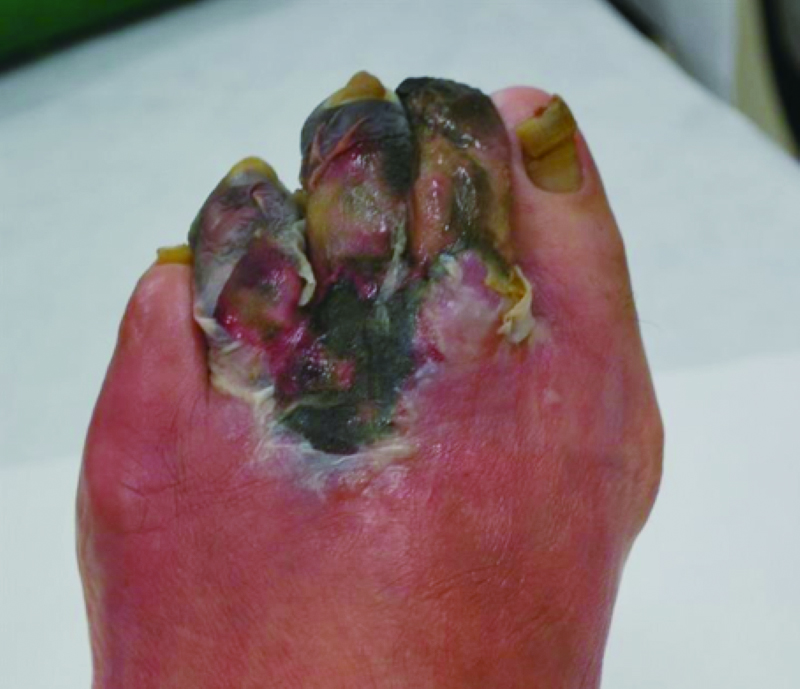- 著者
- Hisashi Motomura Ayaka Deguchi Takaharu Hatano Heishiro Fujikawa Shusaku Maeda Ayami Nobuyama
- 出版者
- Japan Society for Surgical Wound Care
- 雑誌
- International Journal of Surgical Wound Care (ISSN:24352128)
- 巻号頁・発行日
- vol.1, no.1, pp.3-8, 2020 (Released:2020-06-16)
- 参考文献数
- 25
Foot ulcers due to diabetes or/and arteriosclerosis obliterans frequently result in an intractable condition which is refractory to treatment. In order to overcome such a condition, establishing a treatment modality based on the tissue, infection/inflammation, moisture balance, and edge of wound (TIME) concept to clinically perform wound bed preparation (WBP), as advocated by Schulz, is important. Therefore, the following steps are essential: 1) control and treat the disease-causing chronic wounds and 2) evaluate the wounds as per the TIME concept and perform local treatment at the proper timing. The core of this treatment concept is considered to be debridement. Debridement is a procedure carried out to protect the surrounding tissue by cleaning the wound of infectious and necrotic tissues, and this is crucial for chronic foot diseases. Our current strategy consists of two steps: initial medical treatment and subsequent aggressive treatment of the lesion. Our method of performing maintenance debridement, using trafermin spray and aggressive conservative therapy using NPWT, makes TIME-based wound bed preparation possible. Proper debridement at the proper time contributes to the success of this treatment. In this paper, we report the essential factors for debridement and our methods of debridement.
- 著者
- Tomoya Kawabata Mika Ikeda Haruka Matsuzoe Shungo Oka Hiroaki Ohama Takafumi Kabuto Yutaka Takahashi Yuri Shimada Atsushi Nakagawa Kazuya Kataoka
- 出版者
- Japan Society for Surgical Wound Care
- 雑誌
- International Journal of Surgical Wound Care (ISSN:24352128)
- 巻号頁・発行日
- vol.4, no.1, pp.22-28, 2023 (Released:2023-03-01)
- 参考文献数
- 25
When pleural empyema is treated with open-window thoracostomy, only 35% of cases are successfully closed, requiring an average of 4.5 months of treatment until wound closure. Conventional treatments such as daily gauze replacement often result in insufficient re-expansion of the collapsed lung, and surgical procedures such as thoracoplasty, muscle flap transposition, and omentoplasty are often necessary. We report a case of acute pleural empyema secondary to coronavirus disease 2019 treated with negative-pressure wound therapy (NPWT). After a month of conservative treatment following open-window thoracostomy, NPWT was performed for three weeks, and the thoracostoma was completely closed with the expanded lung. Approximately one week later, epithelialization of the exposed pleura was completed, and the patient was discharged. Six months after healing, there was no recurrence of pleural empyema. In this case, NPWT resulted in good pulmonary expansion and likely shortened the healing time. Although NPWT is contraindicated in wounds with exposed organs, the use of a contact layer and appropriate negative-pressure settings ensured safe treatment in our patient. We report the results of this study, along with a review of the available literature.
1 0 0 0 OA Surgical Management for Foul-Smelling Wounds
- 著者
- Kenji Hayashida Shota Suda Sho Yamakawa
- 出版者
- Japan Society for Surgical Wound Care
- 雑誌
- International Journal of Surgical Wound Care (ISSN:24352128)
- 巻号頁・発行日
- vol.3, no.4, pp.149-151, 2022 (Released:2022-12-01)
- 参考文献数
- 10
Microorganisms infiltrate necrotic tissue over time, resulting in wound infections and odor. However, patients with odorous wounds occasionally cannot obtain adequate wound care regarding the odor owing to their systemic state. Although a variety of conservative or interventional wound treatments have been studied, the strategy for managing and caring for odorous wounds remains unknown. Odor can be reduced by preventing microbial colonization or infections that cause an objectionable odor. As a result, wounds are treated with systemic antibiotics and/or topical exudate-control dressings. The most effective method to eliminate wound odors is wound debridement. However, the debridement of necrotic tissue causing malodor is known to be painful unless performed under local or general anesthesia. This adds to physical and mental strain as well as the risk of interventional treatment as a whole. Therefore, an awareness of the fundamental mechanisms of odorous wounds and establishment of treatment strategies for optimal odor management, including aggressive debridement, is essential. The aim of this brief communication is to describe and suggest interventional odor treatment alternatives, focusing on topical surgical management.

